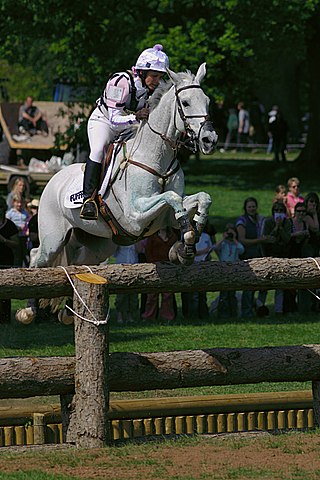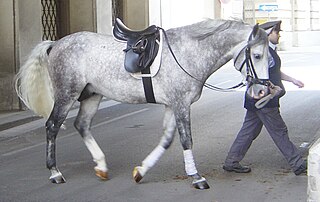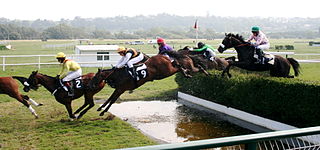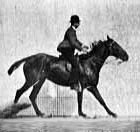Show jumping is a part of a group of English riding equestrian events that also includes eventing, hunters, and equitation. Jumping classes are commonly seen at horse shows throughout the world, including the Olympics. Sometimes shows are limited exclusively to jumpers. Sometimes jumper classes are offered in conjunction with other English-style events. Sometimes, show jumping is but one division of a very large, all-breed competition that includes a very wide variety of disciplines. Jumping classes may be governed by various national horse show sanctioning organizations, such as the United States Equestrian Federation or the British Showjumping Association. International competitions are governed by the rules of the International Federation for Equestrian Sports.

Eventing is an equestrian event where a single horse and rider combine and compete against other competitors across the three disciplines of dressage, cross-country, and show jumping. This event has its roots in a comprehensive cavalry test that required mastery of several types of riding. The competition may be run as a one-day event (ODE), where all three events are completed in one day or a three-day event (3DE), which is more commonly now run over four days, with dressage on the first two days, followed by cross-country the next day and then show jumping in reverse order on the final day. Eventing was previously known as Combined Training, and the name persists in many smaller organizations. The term "Combined Training" is sometimes confused with the term "Combined Test", which refers to a combination of just two of the phases, most commonly dressage and show jumping.

Equestrianism, commonly known as horse riding or horseback riding, includes the disciplines of riding, driving, and vaulting. This broad description includes the use of horses for practical working purposes, transportation, recreational activities, artistic or cultural exercises, and competitive sport.

English saddles are used to ride horses in English riding disciplines throughout the world. The discipline is not limited to England, the United Kingdom in general or other English-speaking countries. This style of saddle is used in all of the Olympic and International Federation for Equestrian Sports (FEI) equestrian disciplines, except for the newly approved FEI events of equestrian vaulting and reining. Most designs were specifically developed to allow the horse freedom of movement, whether jumping, running, or moving quickly across rugged, broken country with fences. Unlike the western saddle or Australian Stock Saddle, there is no horn or other design elements that stick out above the main tree of the saddle.

Equitation is the art or practice of horse riding or horsemanship.

Skijoring is a winter sport in which a person on skis is pulled by a horse, a dog, another animal, or a motor vehicle. The name is derived from the Norwegian word skikjøring, meaning "ski driving". Although skijoring is said to have originated as a mode of winter travel, it is currently primarily a competitive sport.

An assault course is a trail that combines running and exercising. It is often used in military training. The prime use is to evaluate progress and weaknesses of the individual or the team involved.

Canada Olympic Park (COP), formerly known as Paskapoo Ski Hill, is a ski hill and multi-purpose training and competition facility located in Calgary, Alberta, Canada, owned and operated by WinSport. It is currently used both for high performance athletic training and for recreational purposes by the general public. Canada Olympic Park was one of the venues for the 1988 Winter Olympics, being the primary venue for ski jumping, bobsleigh, and luge.

The Hunter division is a branch of horse show competition that is judged on the horse's performance, soundness and when indicated, conformation, suitability or manners. A "show hunter" is a horse that competes in this division.

Hunt seat is a style of forward seat riding commonly found in North American horse shows. Along with dressage, it is one of the two classic forms of English riding. The hunt seat is based on the tradition of fox hunting. Hunt seat competition in North America includes both flat and over fences for show hunters, which judge the horse's movement and form, and equitation classes, which judge the rider's ability both on the flat and over fences. The term hunt seat may also refer to any form of forward seat riding, including the kind seen in show jumping and eventing.

Bascule is the natural round arc a horse's body takes as it goes over a jump. The horse should rise up through its back, stretching its neck forward and down, when it reaches the peak of his jump. Ideally, the withers are the highest point over the fence. This is often described as the horse taking the shape of a dolphin jumping out of the water. Bascule can also refer more generally to the raising of the withers while the horse is in motion.

A steeplechase is a distance horse race in which competitors are required to jump diverse fence and ditch obstacles. Steeplechasing is primarily conducted in Ireland, Great Britain, Canada, United States, Australia, and France. The name is derived from early races in which orientation of the course was by reference to a church steeple, jumping fences and ditches and generally traversing the many intervening obstacles in the countryside.

Rat agility is a sport for pet rats using scaled-down versions of the obstacles used for dog agility events. The sport originated in Sweden and can trace its origin back to table runs in the 1980s, where the owner on one side of the table had to get the rat from the other side to move across the table in the shortest time possible. Rat agility became an official competition in 2000.

Many types of obstacles are found in competitive horse jumping sports such as show jumping, hunter classes, and the cross-country phase of eventing. The size and type of obstacles vary depending on the course designer and the expected difficulty level of a particular competition. Horses will need to negotiate many types of obstacles in order to be successful in jumping sports.

An obstacle is an object, thing, action or situation that causes an obstruction. Different types of obstacles include physical, economic, biopsychosocial, cultural, political, technological and military.

Dog agility is a dog sport in which a handler directs a dog through an obstacle course in a race for both time and accuracy. Dogs run off leash with no food or toys as incentives, and the handler can touch neither dog nor obstacles. The handler's controls are limited to voice, movement, and various body signals, requiring exceptional training of the animal and coordination of the handler.

In sport, score is a quantitative measure of the relative performance of opponents in a sporting discipline. Score is normally measured in the abstract unit of points, and events in the competition can raise or lower the score of the involved parties. Most games with score use it as a quantitative indicator of success in the game, and in competition, a goal is often made of attaining a better score than one's opponents in order to win.
















